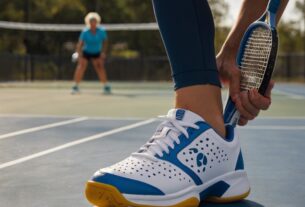When it comes to racket sports, both pickleball and tennis are immensely popular, but they offer unique experiences. If you’re new to these sports, you may wonder: What is the difference between pickleball and tennis? Though they share some similarities, their differences in court size, equipment, playing style, and physical demands make each sport distinct. Here’s a comprehensive look at how pickleball and tennis differ.
Pickleball vs. Tennis: An Overview
While both sports involve hitting a ball over a net, the ways in which they’re played differ greatly. Tennis is considered a more traditional and physically demanding game, while pickleball has emerged as a sport that caters to players of all ages, especially for those seeking a more accessible form of exercise.
Court Size and Layout
The playing area in pickleball is significantly smaller compared to a tennis court, and this directly impacts the pace and style of each game.
- Pickleball Court Dimensions: A standard pickleball court measures 20 feet by 44 feet. This smaller court size allows for quicker movements, which makes pickleball games more centered around positioning and strategy than pure athleticism.
- Tennis Court Dimensions: Tennis courts are much larger, with a singles court measuring 27 feet by 78 feet, and a doubles court extending to 36 feet wide. The larger size makes tennis more physically demanding, as players must cover a lot more ground during rallies.
- Net Height Differences: The net in pickleball is 34 inches high at the center, while in tennis, it is 36 inches. The lower net in pickleball encourages shorter, more strategic shots, while tennis encourages a mixture of power and finesse.
Equipment: Rackets vs. Paddles
The type of equipment used in both sports also sets them apart.
- Pickleball Paddles: Pickleball paddles are usually made from lightweight materials like composite or wood. They are shorter, lighter, and solid-faced, which allows for quick reaction times. The compact design helps players control their shots with greater precision.
- Tennis Rackets: Tennis rackets are much larger and feature strings made from synthetic materials or gut, which give them added tension and power. The larger racket size and heavier weight require more arm strength to generate powerful shots and spins.
The Ball: How It Affects Play
The difference in the ball used in pickleball and tennis plays a crucial role in how each game is played.
- Pickleball Balls: Made from lightweight, perforated plastic, pickleballs resemble wiffle balls. They have a unique flight pattern and do not bounce as high as tennis balls. This encourages players to focus on precise, well-placed shots rather than relying on speed or force.
- Tennis Balls: Tennis balls are made of rubber and covered in felt, making them bouncier and faster. The higher bounce and increased speed contribute to a more aggressive style of play in tennis, where spin, pace, and power are key.
Gameplay Rules: Points and Scoring
The scoring system and gameplay dynamics in pickleball differ from tennis, adding variety to how points are won.
- Pickleball Gameplay: Pickleball games are most commonly played to 11 points, with players or teams required to win by 2 points. Only the serving team can score a point, adding a layer of strategy to the game. Players engage in quick exchanges, where precision and placement are vital.
- Tennis Gameplay: Tennis matches are typically divided into sets. Players need to win six games to win a set, with matches often played in the best-of-three or best-of-five format. Points can be won by either player or team, and the use of spin, volleys, and long rallies makes tennis a more endurance-based sport.
Physical Demands and Pace of the Game
One of the primary differences between pickleball and tennis is the level of physical intensity each sport demands.
- Pickleball: Due to its smaller court size and slower ball speed, pickleball is less physically taxing than tennis. This makes it a great option for people of all ages, particularly seniors, as it allows for a fun and competitive experience without the need for extreme agility or endurance. The game also puts a heavier emphasis on reflexes and hand-eye coordination.
- Tennis: Tennis is far more physically demanding. Players often need to cover large areas of the court, chase down fast-moving balls, and sustain long, grueling rallies. This sport is ideal for those seeking a cardio-intensive workout. Tennis players need stamina, strength, and agility to outlast their opponents during long matches.
Strategy and Skill
Both sports require strategic thinking, but the type of strategy used in pickleball and tennis varies.
- Pickleball Strategy: Pickleball emphasizes finesse over power. Because of the slower ball speed and lower bounce, players engage in tactical dinking rallies (soft, controlled shots just over the net). Quick reflexes and net play are critical. The smaller court means players need to think ahead and control each point with careful shot placement.
- Tennis Strategy: Tennis rewards a blend of power and control. Players often rely on forceful serves and groundstrokes to dominate the baseline. Strategy in tennis often revolves around varying the pace, applying topspin or slice to keep opponents off balance. Tennis matches can become battles of endurance, where physical conditioning plays a key role.
Popularity and Accessibility
- Pickleball Popularity: Pickleball has grown exponentially in recent years, especially in North America. Its accessibility and low barrier to entry make it an appealing sport for a wide range of age groups. Public parks and recreation centers often have dedicated pickleball courts, and the game’s friendly community vibe attracts social players.
- Tennis Popularity: Tennis remains a globally recognized sport with a rich history. It continues to be a popular option in professional and amateur circuits worldwide. Tennis is also included in major international tournaments like the Grand Slams, contributing to its longstanding fame.
Both pickleball and tennis are fantastic sports, but they cater to different interests and abilities. If you’re looking for a less intense, highly social game, pickleball is the way to go. On the other hand, if you enjoy fast-paced, high-energy competition that requires stamina and physical strength, tennis will be more your speed. Understanding the key differences between pickleball and tennis can help you decide which sport best fits your lifestyle and athletic goals.




